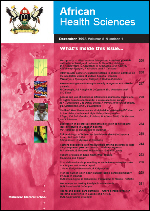
|
African Health Sciences
Makerere University Medical School
ISSN: 1680-6905
EISSN: 1680-6905
Vol. 14, No. 1, 2014, pp. 185-188
|
 Bioline Code: hs14028
Bioline Code: hs14028
Full paper language: English
Document type: Research Article
Document available free of charge
|
|
|
African Health Sciences, Vol. 14, No. 1, 2014, pp. 185-188
| en |
In vitro evidence for endocrine-disrupting chemical (EDC)’s inhibition of drug metabolism
Wei-Ping, Li; Yu-Feng, Wang; Jian, Gao; Ming-Lian, Yu; Yan-Yang, Tu & Yuan-Qing, Yao
Abstract
Background: Humans can be frequently exposed to Bisphenol A (BPA) via multiple sources, and babies are considered to be the most sensitive group to exposure of BPA.
Aims: To investigate the inhibition potential of BPA towards human liver microsomes (HLMs)-catalyzed zidovudine (AZT) glucuronidation.
Materials and Methods: In vitro HLMs incubation system was used to investigate the inhibition potential of BPA towards AZT glucuronidation. Both Dixon and Lineweaver-Burk plots were employed to determine the inhibition kinetic type, and nonlinear repression was utilized to calculate the inhibition kinetic parameters (Ki).
Results: Concentration-dependent inhibition of BPA towards AZT glucuronidation was observed. Both Dixon and Lineweaver-Burk plots showed that BPA exerted competitive inhibition towards the glucuronidation of AZT, and nonlinear repression with competitive equation was used to calculate the Ki value to be 3.2 μM.
Conclusion: Potential BPA-AZT interaction might occur when the patients administered with AZT is also exposed to BPA.
Keywords
Bisphenol A (BPA); zidovudine (AZT); human liver microsomes (HLMs)
|
| |
© Copyright 2014 - African Health Sciences
|
|
